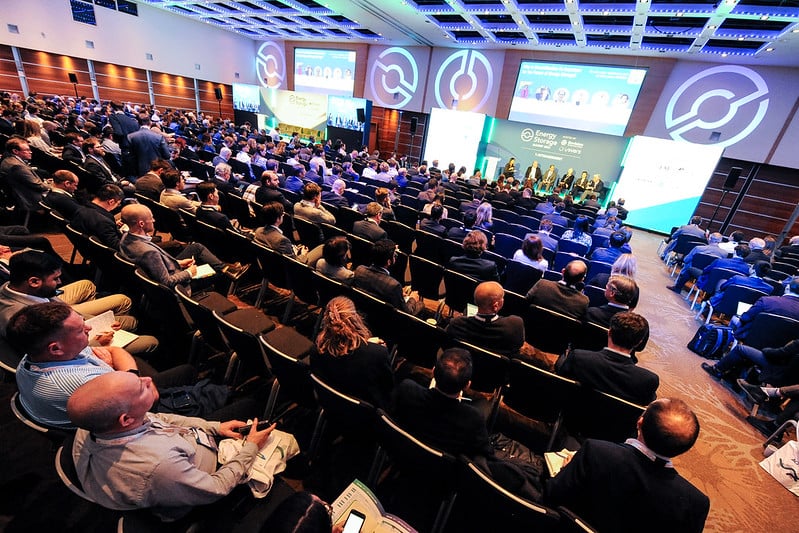
Europe’s energy storage industry and key stakeholders arrive in London for the 2025 Energy Storage Summit EU in just a few days.
Taking place next week (18, 19 February) at the Intercontinental Hotel at London’s iconic O2 complex, the conference is now in its tenth year, and our team look forward to meeting many of you there.
Enjoy 12 months of exclusive analysis
- Regular insight and analysis of the industry’s biggest developments
- In-depth interviews with the industry’s leading figures
- Annual digital subscription to the PV Tech Power journal
- Discounts on Solar Media’s portfolio of events, in-person and virtual
International focus
The event is held in the UK, which has, for some years, been Europe’s biggest market for large-scale battery storage deployment. According to data from Solar Media Market Research’s ‘Battery Storage: UK Pipeline & Completed Assets Database’ report, there is now 6GW/8GWh of large-scale battery energy storage system (BESS) technology on the grid and almost 20GWh in construction.
We are privileged to welcome keynote speakers including Duncan Stone, deputy director for smart electricity systems at the UK government’s Department for Energy Security & Net Zero (DESNZ) and Mike Thompson, chief economist at the National Energy System Operator (NESO) for Great Britain.
However, while there will be some targeted focus on the UK market and its exciting dynamics, the Energy Storage Summit EU is also very international in scope.
Other keynote speakers include Brent Wanner, head of the power sector unit of the International Energy Agency (IEA) World Energy Outlook, who will be offering insights into how the European Union (EU) can achieve its 200GW energy storage target by 2030.
There are also keynote panels that will debate the outlook for Europe’s hottest markets, discuss the long-term vision for energy storage from a system planner perspective, including northern and southern Europe and the Nordic markets, and discuss how to build a bankable business case for European projects with a focus on risk and offtake agreements, to give just three more examples from a packed bill.
All aspects of BESS technology
Technology is what drives this business forward, and attendees will have plenty of opportunities to learn from industry-leading players on topics ranging from mitigation of safety risks and noise concerns from a system design perspective to innovations in hybrid and advanced power conversion systems (PCS), commercial and industrial (C&I) and mobile energy storage.
Of course, multiple sessions will be held on the latest in utility-scale storage innovation, from large-format cells and high-energy-density containers to augmentation, operations and maintenance (O&M), and route-to-market software and trading platforms.
Adjacent topics like co-location with renewables, grid connections, the rise of artificial intelligence (AI) and workforce development will also take centre stage at the storage summit.
This year, in addition to the expanded conference agenda, there will also be a larger expo area where you can meet the speakers and get firsthand introductions to their technologies and offerings.
Business and investment cases for a thriving industry ecosystem
While technology is the driving force, it is the business case for energy storage technologies and the market opportunities that underpin the industry, ultimately presenting the make-or-break barriers or ways forward.
Panels and presentations will cover every aspect of the energy storage business from investment and development to operation and optimisation.
Highlights include:
- Top storage investors taking part in a fireside chat on what makes them choose a developer to back
- A discussion of which European markets present merchant opportunities versus contracted revenues and what makes some more attractive than others
- Why the long-term investment appetite for renewables and storage is stronger than ever despite challenging capital market conditions
- The evolution of the BESS revenue stack over time.
Notes from Day One chair Roger Harrabin
Although the industry is in a better place than ever in many ways, there’s still a lot to do for energy storage to truly fulfil its role as a key pillar of the energy industry, as Day One chair Roger Harrabin notes.
Harrabin, a former BBC correspondent of 35 years and presently a fellow at St Catharine’s College, Cambridge, tells Energy-Storage.news that energy storage is often neglected by policymakers.
“There’s an expectation among many governments that carbon capture, hydrogen and nuclear power will be key technologies,” Harrabin says.
“The tech that really needs support now is storage.”
The world is at a “weird moment in history with energy and climate change,” Harrabin says. While the recent Los Angeles wildfires and Queensland floods show the immediate threat of climate, there’s a rift in policy dynamics “between the UK striving to meet its carbon targets and President Trump insisting that climate is no great concern.”
Harrabin says that, on the other hand, China’s leaders have identified both the threat of climate crisis and the opportunity to retool the energy industry with low-carbon technologies for the present and future.
On a personal note, Roger Harrabin says that while lithium-ion (Li-ion) has dominated the market and serves vital roles, there is growing investment in other technologies, including non-lithium electrochemical (flow batteries, sodium-ion, iron-air). His interest has been piqued by thermal energy storage and the broad decarbonisation opportunities it presents.
“With climate change bearing down upon us, we need these ‘Cinderella’ technologies alongside lithium-ion, and we need to scale them very, very fast,” he says.
The Energy Storage Summit EU takes place next week (18, 19 February) at the Intercontinental Hotel London- The O2. Visit the event website for more information and tickets.

